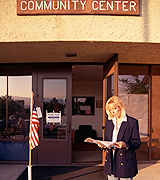
Sharing Expertise, Collaborating and Serving as Ambassador
Integration of Foreign Born Faculty in Academia
Athanase Gahungu, International Journal for Leadership Preparation
This review of literature explored issues of obstacles and opportunities for foreign-born faculty to become fully integrated in academia, particularly in programs that do not traditionally attract international scholars.
The Center for Community Engagement
California State University
Iinitiatives, resources, news and campus contacts for the 23 campuses of the CSU with regards to community engagement.
Academic Community Engagement Grants
Jefferson Public Citizens Program, Office of the Executive Vice President and Provost, University of Virginia
Ways s a campus may support and facilitate the involvement of faculty members in community engagement.
Report of the Senate Academic Standards, Regulations, and Admissions Committee on Faculty Role in Undergraduate Admissions and Recruitment
Rutgers University (April, 2005)
Outlines the vital role that faculty members play in recruitment of Rutgers students.
Media Guide to Publishing Your Opinion
Sonoma State University
Offers guidelines for op-ed articles that engage readers.
Community Leadership
Faculty service to external organizations
In addition to expectations that faculty members serve campus committees and student organizations, there are a number of external activities that require the service of academics. These groups, boards and review teams rely on the time and expertise of many individuals to accomplish their work. Whether as a participant, a presenter or a consultant, faculty member service is a critical component of successful operations. New faculty members should expect to gradually increase their engagement with off campus entities as they progress through their career.
Professional organizations and boards
Disciplinary service involves faculty members contributing to their disciplinary associations or working as editors for disciplinary journals. In addition to professional organizations connected with specific disciplines, there are higher education organizations that address general issues in the academic community. The involvement of faculty members in these organizations is a key element to their functioning effectively. New faculty members should plan to engage in service activities to help professional organizations meet the needs of their members.
Community organizations and boards
Faculty members provide community service through contributions in the civic arena such as board or committee membership, or volunteer work with philanthropic and other non-profit organizations. Examples of this sort of work may include speeches, continuing or extension education activities, policy analysis, or assistance with grant proposals. These services may be provided to a local Chamber of Commerce, non-profit organizations such as health centers or special interest groups, or governmental groups. Faculty participation with community groups helps them be more effective, respond to problems in the community, and facilitates utilization of the expertise a university offers.
Governmental agencies
Cooperation with local, regional and state governmental agencies is another way for faculty members to serve the public. Collaborations of this type are ideal for capitalizing on the expertise of university faculty. Whether city, county, state or national agencies, in health, safety, planning, schools, or local government, the service faculty members provide makes a difference in the smooth and effective progress that government agencies make towards their goals. Establishing relationships through service is one effective way that new faculty members make important networking connections that may lead to other opportunities in the future.
Task forces
A task force is a smaller subgroup of a larger body that takes on a small task that requires immediate attention. It may involve doing some research on an issue, exploring options, making recommendations to the larger body or other similar activities. Task forces that faculty members serve on may be on their campus, affiliated with other campuses, or part of the service that faculty members are involved with for community and governmental groups.
Public relations
A big part of the recruitment, retention and success of students is based on the reputation a campus has for academics, extracurricular activities, and learning opportunities in the larger community. Faculty members are frontline ambassadors that help craft that perception. Whether making public the findings of their research, making the effort to be an outstanding teacher, or engaging in service that raises the profile of the campus, faculty members are a large part of public relations for the campus.
Possible questions to ask about Community Leadership:
- Professional organizations and boards
Whether discipline specific or general higher education professional organizations, what is the role of faculty members and how is it negotiated? - Community organizations and boards
In what ways do community organizations and boards depend upon faculty members, and how does the work fit within the larger framework of academic responsibilities? - Governmental agencies
What sorts of service might faculty members provide to governmental agencies? - Task forces
What are some examples of the focus and work of task forces on which faculty members may serve? - Public relations
How does the service of faculty members contribute to the public image of a campus?


